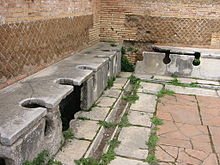Xylospongium


The Xylospongium, also known as sponge on a stick, is the ancient precursor of the modern toilet brush. It consists of a wooden stick (Greek: ξύλον, Xylon) with a sponge (Greek: Σπόγγος, Spongos) fixed at one end.
In the classical antiquity a xylospongium might be used in the same way as we use a toilet brush.[1] All primary sources implicate the use of a xylospongium in the context of ancient latrines. But none clarifies the handling exactly.
In the baths of the seven sages in Ostia, a fresco from the 2nd century contains the Inscription (u)taris xylosphongio[2] which is the first known mention of the term. Also in the early second century a papyrus letter of Claudius Terentianus to his father Claudius Tiberianus uses the term xylospongium in a phrase.[3]
In the middle of the first century Seneca reported that a Germanic gladiator commits suicide with a sponge on a stick. The Germanic hides himself in the latrine of an amphitheater and pushed the wooden stick in his gullet.[4]
References
- ^ Wiplinger 2012, S. 300-301.
- ^ L'Année épigraphique 1941, 5.
- ^ (29)…Non magis quravit me pro xylesphongium meo. Non magis cunavit me quam xylosphongium (30) sed siam negotium ct circa res suas. – Translation: (29)…He did not care for me more than for a xylospongium, (30) even for his own things. (Michigan Papyri VIII, 29-30)
- ^ Seneca, Epistulae morales 8, 70, 20. …lignum id, quod ad emundanda obscena adhaerente spongia positum est…
Primary Sources
- Claudius Terentianus, Michigan Papyri VIII, 29-30.
- Seneca, Epistulae morales Liber 8, 70, 20.
- Martial, Epigrammata, Liber 12,48,7.
Bibliography
- Richard Neudecker: Die Pracht der Latrine. Zum Wandel öffentlicher Bedürfnisanstalten in der kaiserzeitlichen Stadt. Pfeil-Verlag, München 1994 (Studien zur antiken Stadt, Bd. 1) ISBN 3-923871-86-4, pp. 36f.
- Gilbert Wiplinger: Der Gebrauch des Xylospongiums – eine neue Theorie zu den hygienischen Verhältnissen in römischen Latrinen. In: SPA . SANITAS PER AQUAM. Tagungsband des Internationalen Frontinus-Symposiums zur Technik – und Kulturgeschichte der antiken Thermen Aachen, 18. – 22. März 2009. Frontinus-Gesellschaft e.V. & Peeters, Leiden 2012. ISBN 978-90-429-2661-5. pp. 295–304.
